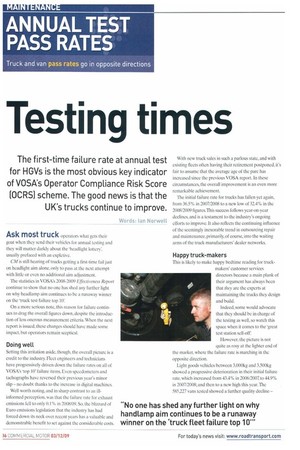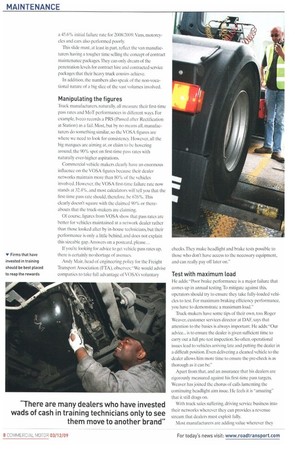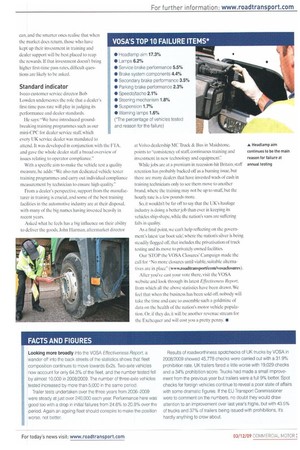Testing times
Page 38

Page 40

Page 41

If you've noticed an error in this article please click here to report it so we can fix it.
The first-time failure rate at annual test for HGVs is the most obvious key indicator of VOSA's Operator Compliance Risk Score (OCRS) scheme. The good news is that the UK's trucks continue to improve.
Words: Ian Norm!'
Ask most truck operators what gets their goat when they send their vehicles for annual testing and they will mutter darkly about the 'headlight lottery', usually prefaced with an expletive.
CM is still hearing of trucks getting a first-time fail just on headlight aim alone, only to pass at the next attempt with little or even no additional aim adjustment.
The statistics in VOSA's 2008-2009 Effectiveness Report continue to show that no one has shed any further light on why headlamp aim continues to be a runaway winner on the 'truck test failure top 10:
On a more serious note, this reason for failure continues to drag the overall figures down, despite the introduction of less onerous measurement criteria. When the next report is issued, these changes should have made some impact, but operators remain sceptical.
Doing well
Setting this irritation aside, though, the overall picture is a credit to the industry. Fleet engineers and technicians have progressively driven down the failure rates on all of VOSA's 'top 10' failure items. Even speedometers and tachographs have reversed their previous year's minor slip — no doubt thanks to the increase in digital machines.
Well worth noting, and in sharp contrast to an illinformed perception, was that the failure rate for exhaust emissions fell to only 0.1%) in 2008/09, So. the blizzard of Euro emissions legislation that the industry has had forced down its neck over recent years has a valuable and demonstrable benefit to set against the considerable costs. With new truck sales in such a parlous state, and with existing fleets often having their retirement postponed. it's fair to assume that the average age of the pare has increased since the previous VOSA report. In these circumstances, the overall improvement is an even more remarkable achievement.
The initial failure rate for trucks has fallen yet again, from 36.5% in 2007/2008 to a new low of 32.4% in the 2008/2009 figures. This success follows year-on-year declines, and is a testament to the industry's ongoing efforts to improve. It also reflects the continuing influence of the seemingly inexorable trend in outsourcing repair and maintenance, primarily, of course, into the waiting arms of the truck manufacturers' dealer networks.
Happy truck-makers
This is likely to make happy bedtime reading for truck
makers' customer services directors because a main plank of their argument has always been that they are the experts at maintaining the trucks they design and build.
Indeed, some would advocate that they should be in charge of the testing as well, so watch this space when it comes to the 'great test station sell-off!
However, the picture is not quite as rosy at the lighter end of the market, where the failure rate is marching in the opposite direction.
Light goods vehicles between 3,000kg and 3,500kg showed a progressive deterioration in their initial failure rate, which increased from 43.4% in 2006/2007, to 44.9% in 2007/2008; and then to a new high this year. The 585,227 vans tested showed a further quality decline —
a 45.6% initial failure rate for 2008/2009. Vans, motorcycles and cars also performed poorly.
This slide must, at least in part, reflect the van manufacturers having a tougher time selling the concept of contract maintenance packages. They can only dream of the penetration levels for contract hire and contracted service packages that their heavy truck cousins achieve.
In addition, the numbers also speak of the non-vocational nature of a big slice of the vast volumes involved.
Manipulating the figures
Truck manufacturers, naturally, all measure their first-time pass rates and MoT performances in different ways. For example, Iveco records a PRS (Passed after Rectification at Station) as a fail. Most, but by no means ail, manufacturers do something similar, so the VOSA figures are where we need to look for consistency. However, all the big marques are aiming at, or claim to be hovering around, the 90% spot on first-time pass rates with naturally ever-higher aspirations.
Commercial vehicle makers clearly have an enormous influence on the VOSA figures because their dealer networks maintain more than 80% of the vehicles involved. However, the VOSA first-time failure rate now stands at 32.4%, and most calculators will tell you that the first-time pass rate should, therefore. be 676%. This clearly doesn't square with the claimed 90% or thereabouts that the truck-makers are claiming.
Of course, figures from VOSA show that pass rates are better for vehicles maintained at a network dealer rather than those looked after by in-house technicians, but their performance is only a little behind, and does not explain this sizeable gap. Answers on a postcard, please...
If you're looking for advice to get vehicle pass rates up, there is certainly no shortage of avenues.
Andy Mair, head of engineering policy for the Freight Transport Association (ETA), observes: "We would advise companies to take full advantage of VOSA's voluntary checks. They make headlight and brake tests possible to those who don't have access to the necessary equipment, and can really pay off later on."
Test with maximum load
He adds: "Poor brake performance is a major failure that comes up in annual testing. To mitigate against this, operators should try to ensure they take fully-loaded vehicles to test. For maximum braking efficiency performance, you have to demcinstrate a maximum load."
Truck-makers have some tips of their own, too. Roger Weaver, customer services director at OAF, says that attention to the basics is always important. He adds: "Our advice.., is to ensure the dealer is given sufficient time to carry out a full pre-test inspection. So often, operational issues lead to vehicles arriving late and putting the dealer in a difficult position. Even delivering a cleaned vehicle to the dealer allows him more time to ensure the pre-check is as thorough as it can be."
Apart from that, and an assurance that his dealers are rigorously measured against his first-time pass targets, Weaver has joined the chorus of calls lamenting the continuing headlight aim issue. He feels it is "amazing" that it still drags on.
With truck sales suffering, driving service business into their networks wherever they can provides a revenue stream that dealers must exploit fully.
Most manufacturers are adding value wherever they can, and the smarter ones realise that when the market does return, those who have kept up their investment in training and dealer support will be best placed to reap the rewards. If that investment doesn't bring higher first-time pass rates, difficult questions are likely to be asked.
Standard indicator
Iveco customer service director Bob Lowden underscores the role that a dealer's first-time pass rate will play in judging its performance and dealer standards.
He says: "We have introduced groundbreaking training programmes such as our mini-CPC for dealer service staff, which every UK service dealer was mandated to attend. It was developed in conjunction with the VIA, and gave the whole dealer staff a broad overview of issues relating to operator compliance."
With a specific aim to make the vehicle test a quality measure, he adds: "We also run dedicated vehicle tester training programmes and carry out individual compliance measurement by technician to ensure high quality."
From a dealer's perspective, support from the manufacturer in training is crucial, and some of the best training facilities in the automotive industry are at their disposal. with many of the big names having invested heavily in recent years.
Asked what he feels has a big influence on their ability to deliver the goods, John Harman, aftermarket director at Volvo dealership MC Truck & Bus in Maidstone, points to "consistency of staff, continuous training and investment in new technology and equipment': While jobs are at a premium in recession-hit Britain, staff retention has probably backed off as a burning issue, but there are many dealers that have invested wads of cash in training technicians only to see them move to another brand, where the training may not he up to snuff but the hourly rate is a few pounds more.
So, it wouldn't be far off to say that the UK's haulage industry is doing a better job than ever in keeping its vehicles ship-shape, while the nation's vans are suffering falls in quality As a final point, we can't help reflecting on the government's latest 'car boot sale', where the nation's silver is being steadily flogged off, that includes the privatisation of truck testing and its move to privately owned facilities Our 'STOP the VOSA Closures' Campaign made the call for "No more closures until viable, suitable alternatives are in place" (www.roadtransportkonikosaclosures).
After you've cast your vote there, visit the VOSA website and look through its latest Effectiveness Report, from which all the above statistics have been drawn. We feel that when the business has been sold off, nobody will take the time and care to assemble such a goldminc of data on the health of the nation's motor vehicle population. Or, if they do, it will be another revenue stream for the Exchequer and will cost you a pretty penny. •














































































































































